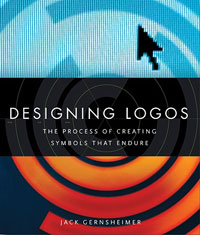Everyone and their brother seems to a logo designer and logo design expert these days, no matter how much (or little) experience they’ve had — and without the slightest mention of a formal education. Blogs hum, faceless unknowns pontificate logo design, and there’s even a “logo of the day” site. One popular logo blogger has climbed to unimaginable popularity with “lists” of logos regurgitated from other people’s sites and no content of his own. Facebook, Tumblr and LinkedIn buzz with “logo designing” experts from all over the world. I searched for Logo Design and got 40-million hits. It’s amazing.
![]() Everyone and their brother seems to a logo designer and logo design expert these days, no matter how much experience they’ve had — and without the slightest mention of a formal education. Blogs hum, faceless unknowns pontificate logo design, and there’s even a “logo of the day” site. One popular logo blogger has climbed to unimaginable popularity with “lists” of logos regurgitated from other people’s sites and no content of his own. Facebook, Tumblr and LinkedIn buzz with “logo designing” experts from all over the world. It’s amazing.
Everyone and their brother seems to a logo designer and logo design expert these days, no matter how much experience they’ve had — and without the slightest mention of a formal education. Blogs hum, faceless unknowns pontificate logo design, and there’s even a “logo of the day” site. One popular logo blogger has climbed to unimaginable popularity with “lists” of logos regurgitated from other people’s sites and no content of his own. Facebook, Tumblr and LinkedIn buzz with “logo designing” experts from all over the world. It’s amazing.

Back in 2008 I surveyed 60 blogs from unknown “designers” who pointed out this or that “good” logo. Their followers all commenting with raves on what a good job they’re doing in identifying such wonderful logo works. Today, you go on LinkedIN, to any of the design discussion groups, and you get these “designing” people showing off and discussing their “logos” … half the time, the examples they’re showing aren’t even logos! The problem I discovered is 99% of the logos being celebrated in most of those blogs won’t pass the acid test. And it’s a shame too, because the bloggers are promoting bad design to young, impressionable designers who will take that as design gospel.
Following in our “design” series, we turn to Jack Gernsheimer, noted designer of fortune 500 brands and identity campaigns, to bring some sanity into focus. His works are broad and varied, and unquestionably effective in the true sense of design. In Jack’s latest book, he explains …
Ten Characteristics of a Logo That Endures
In chapter 2 of Jack’s book Designing Logos: The Process of Creating Symbols That Endure he covers ten attributes that a good logo should possess. It forms a check list that designers can follow in the development of a logo. I’ll not excerpt the full text here, because he goes into considerable detail on each point. But I will quote the steps and then expect you to buy the book as part of your continuing education.
Is the logo distinctive? Jack says: “Ideally, the logo should stand out in a crowded field by virtue of its unique appearance. “
Is the logo sophisticated? Here, the rule is not always constant — but, according to Gernsheimer, “95% of the time, clients want their logos to reflect a sense of good taste and sophistication. When that is the case, the avoidance of inappropriate imagery, fonts, colors and motifs is the key.”
Is the logo conceptual? By ‘conceptual’ Jack refers to qualities “born of intelligent thought”; which should be evident to the viewer.
Is the logo relevant? Jack writes: “The inclusion of one or more relevant visual elements, providing they don’t undermine the simplicity of the logo, adds layers of secondary information about the entity.” In other words, it relates more closely to the entity it represents.
Is the logo versitile? This is where amateur logos will fail if even strong in all the other criteria. In fact, versatility is the first rule I apply to symbol and logo design unless finite usage has been defined. Jack writes: “Whether the logo is applied to a sixty-goot-high oil tank or a ballpoint pen, it should read well.” A good logo will reproduce well on most any surface, in color or black and white.
Is the logo cohesive? This is another that traps many would-be graphic designers. They’ll run into a situation that suggests some form of containment is necessary — which is rather an indication of the lack of cohesiveness. Jack writes: “If you feel the need to draw a box, circle or other shape around the logo, chances are the design lacks the cohesive quality that visually contains a good mark… When elements within a logo appear detached from one another, the logo tends to look fragmented and disjointed.”
Is the logo attractive? Although this criteria gets a bit subjective, since beauty is in the eye of the beholder, Jack notes “… there are things of beauty that have a broad, if not universal, appeal to viewers … the goal is to design a logo that has visual appeal to the greatest number of possible viewers.”
Is the logo legible? This is another area where poorly designed marks will fail. Sometimes the designer will modify typography or symbology to the point that it loses the ability to communicate quickly and effectively. Jack points out: “While it’s tempting and often desirable to customize characters and create ligatures, care should be taken to keep the logo [or logotype] as legible as possible.”
Is the logo memorable? Possibly the most difficult to achieve, this attribute is a must if the logo is to be a success. The only way to know is to test, test, test. But what makes it memorable? Jack writes: “If properly designed, a frequently seen logo will be readily recalled by a viewer. A mark that is simple in its construction, though not necessarily in concept, is generally easier to recall.” This, of course is of paramount importance because of brand loyalty.
Is the logo enduring? This one, of course, is very difficult to predict. One can only hope to design a logo that will be as effective two to fifty years from now. But Jack points out: “The best way to ensure the longevity of a logo is to stay away from trendy imagery, fonts and colors that tend to date the logo.”
As I said before, these points only skim the surface of design rules and ideology that must be considered by designers. At the end of chapter 2, Jack makes the most important statement of all:
“Keep in mind that a poorly designed logo, beautifully and consistently adapted across a visual identity campaign, may well be more impressive than an awesome logo weakly and inconsistently applied to components. Of course, one should strive for nothing less than the ideal combination of a great logo brilliantly applied.”
Designing Logos: The Process of Creating Symbols That Endure
This essential book for all graphic designers looks at the process of logo design and the criteria used to determine whether or not a logo stands a good chance of being here down the road. Whether you’re an educator, a student of design, a CEO recognizing the need for a corporate identity change, or just a fan of strong design, this book will help you make a more well-informed decision about the quality of logos.
Designers, educators, students, marketing specialists, and fans of design need look no further than this invaluable sourcebook for answers to these questions and many more. Packed with tips and lavishly illustrated, Designing Logos is an accessible reference for the design and implementation of a logo — from the initial creative thought process, through the presentation of logo alternatives to a client, to final implementation, with valuable, practical information
Designing Logos: The Process of Creating Symbols That Endure
Author: Jack Gernsheimer
8 1/2 x 10, 214 pages, Paperback
Prolific designer Jack Gernsheimer demonstrates the trial and error behind many successful logos, offering a number of case studies to dissect the design process of recognizable marks. As added inspiration for any designer or aspiring designer, a detailed timeline explores the creative process behind famous logos from Steinway & Sons to National Geographic. Designing Logos is an essential tool for making well-informed decisions about the quality of logos.

Jack Gernsheimer received a BFA in Advertising Design from Syracuse University in 1968 and began his career at J. Walter Thompson in New York. He founded Partners Design with his twin brother Jeff in 1971 and continues to be actively involved in design and creative direction. In 1978, Jack worked in Oslo with internationally acclaimed designer Bruno Oldani. He has designed nearly 500 logos for businesses ranging from Fortune 500 companies to one-person startups. His work has appeared in Communication Arts, Graphis, Print, Novum, and other prestigious international publications. He has lectured, written about, and taught graphic design at Pennsylvania School of Art and Design, and Kutztown University of Pennsylvania.
Special thanks to Allworth Press, www.allworth.com for allowing us to share this information with DTG readers. All text and images excerpted from Designing Logos: The Process of Creating Logos that Endure by Jack Gernsheimer, published by Allworth Press, 2008. Used by permission, all rights reserved.
This article was originally published in 2008 at : https://graphic-design.com/wp-content/uploads/graphic-design.com/DTG/logos/design.html
